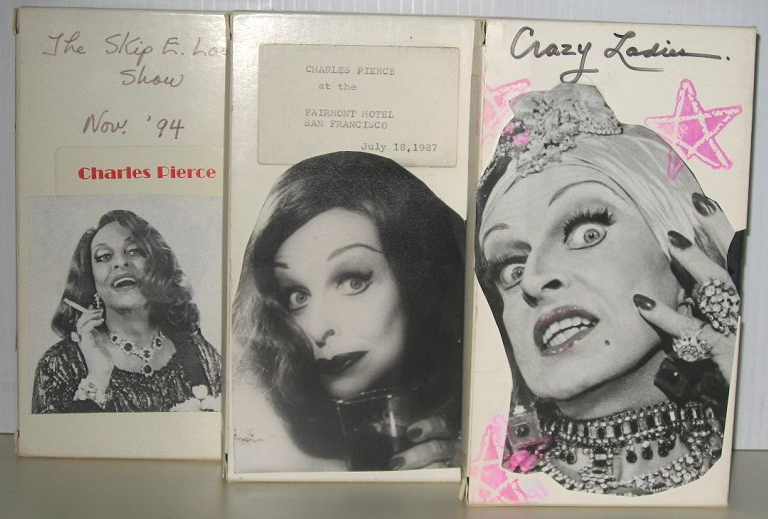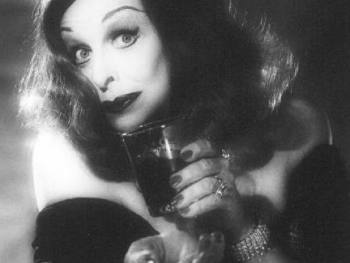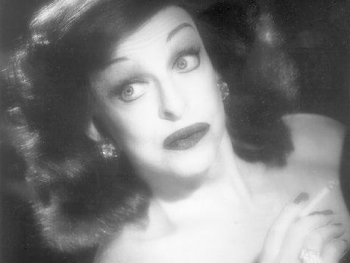Very Recent History: Charles Pierce
by Daniel D’Addario

Today’s top actresses (your Natalie Portmans, Reese Witherspoons, your-what the hell?-Rachel McAdamses) are all arch-feminine. They play vulnerable, lissome, thin, and, often, ever-so-polite. It’s been that way for a while. Who was the last big movie star who broached any sort of gender boundary? Kathleen Turner, maybe-and where is she? On a recent episode of RuPaul’s Drag Race, in which the contestants and RuPaul manques were asked to impersonate celebrities, not a single current movie star was represented, unless you count Paris Hilton. Have you ever seen a drag queen impersonate Gwyneth Paltrow?
The 1940s and 1950s, though, were lousy with actresses with husky voices, aggressive manners and nicotine habits. Think of most of the female celebrities Madonna mentions in “Vogue,” and the ones she doesn’t, such as Tallulah Bankhead. It was an ideal time for that thing that came before the drag queen-the female impersonator. Perhaps the greatest of all was “female impersonator” Charles Pierce: cabaret performer, sort-of socialite, and one of the improbable successes of the American theater. In terms of semiotic play, he was what Lady Gaga would have been if she were sixty years older, and actually had a penis.
Pierce was born in 1926-like any year before, say, 1970, an unfortunate time to be born gay. He grew up identifying with performers, but not necessarily female performers. While he did attend elementary school for Halloween dressed as Mae West, he was just as interested in male stars. “I was always prepared to do a character from the movies that I’d seen; I never just actually dressed up to be a woman. I dressed up to be Mae West or Bette Davis or W. C. Fields or whoever, and then one thing led to another,” Pierce said in an interview for an oral-history project at Southern Methodist University in 1989, ten years before his death. Bette Davis and W. C. Fields were indistinguishable to him: both were famous, and if he had to dress up like a woman to tell the crude, campy jokes he liked, so be it.
Pierce’s early career was unrecognizable by today’s standards of female impersonation. He bore more similarity to the after-hours drag queens on RuPaul’s show, sitting around with smeared makeup and wig caps but no wigs, after they’ve stopped trying to convince their viewer that they’re “real” women. Pierce started out as a female impersonator by pantomiming Julie Andrews, while wearing a portmanteau outfit of a dress, men’s trousers, and a turtleneck. He was not trying to convince anyone of anything, besides that he was funny.
Even after he was legally allowed to take on full drag (as he hadn’t been in his Andrews era, in Miami in the early 50s), his makeup was plastered on mannish features and his gowns and jewelry were both overdone and comically threadbare. He was nothing like his forebear, the female impersonator Julian Eltinge, who slaved over the ultimate everywoman persona in the 1900s and 1910s (“Part of the admiration of his performances came from how convincing they were and how seriously he took them — his carriage, his make-up, his fashion,” wrote historian Daniel Hurewitz). There’s no finesse in Pierce, as there had been in Eltinge’s act, or the cyborgially perfect drag queens of the 2000s. That there’s quite obviously a man putting on a Bette Davis impersonation is part of the joke, one as much at Davis’s expense as it is at the performer’s own.

For as gender-bending as Davis was-a sexual aggressor who made raunchy jokes-Pierce eradicated every bit of her still-apparent femininity. As part of his early nightclub act, Pierce applied an archetype of Davis’s abrasive, curt sexuality to the character of Scarlett O’Hara, as a means of eradicating both Davis’s and Vivien Leigh’s beauty. As a person with about as little agency as anyone could have to form a legitimate Hollywood career-though Pierce carried on correspondences with Eileen Atkins, Phyllis Diller, and Harvey Fierstein, and landed a supporting role as the drag queen “Bertha Venation” in Fierstein’s Torch Song Trilogy-Pierce had to reappropriate the images and personae of the stars he loved in order to end up famous himself.
Even into the 1970s, as Pierce’s career picked up, female impersonators were still widely misunderstood. The diary of the pseudonymous Ralph Werther, himself a drag performer who wrote under an assumed name so as to “not risk disgrace to [his] family name,” was originally published in 1918 (and reprinted in 2008). Werther-who performed as “Jennie June,” wrote that female impersonators tended to be “androgynes.” He wrote: “Whoever has beheld an instinctive female-impersonator when keyed up, must confess that this type are born actors-or ‘actresses,’ as they prefer to be called. Their histrionic skill is not primarily the result of practice or instruction.” Maybe Werther understood more than he let on.
In 1975, Pierce performed for the first time in New York after building up his act in San Francisco. Clive Barnes wrote in the New York Times that, though he usually loathed drag acts…
[Pierce] is a fantastically funny and outrageous man. […] They [Pierce as well as a British performer] are drag-kings not drag-queens. They never for one moment pretend to be women — they are always men dressed up as women. Mr. Pierce does not either talk like a woman or, essentially, move like a woman.

When he pretended to be Bette Davis in All About Eve, as he would throughout his career, Pierce would wear a copy of her “black Edith Head cocktail gown,” as he lovingly described it. But while Davis’s character declares that the one “career all women have in common [is] being a woman,” Pierce’s career had very little to do with being a woman, and much to do with being himself. “I use them,” he said of actresses, “almost as my ventriloquist dolls. I more or less express myself through them.”
And “himself”-a classically camp, witty comedian whose brief Torch Song Trilogy performance is a high point in a dirgey gay tragedy-was highly appealing, to those who found out about Pierce over his long career. An admirer sent him a letter in 1974-now on file at the New York Public Library for the Performing Arts-saying “It just kills me that I’ve seen so many lesser talents in higher paying jobs with more prestige, and it just isn’t fair.”
Pierce never seemed unsatisfied-the admirer’s letter confesses surprise at Pierce’s contentment, and Pierce gleefully tells his SMU interviewer that Claudette Colbert, Ingrid Bergman, and the Golden Girls have seen his act. But the tide, anyway, was gradually moving away from the sorts of actresses Pierce could lampoon. As he said in that SMU interview, of Davis, Crawford, Bankhead, and the rest: “These women are from a certain era, and they’re very imitable. Who are you going to imitate today-Molly Ringwald?” Watching RuPaul’s Drag Race, in which RuPaul and Lisa Rinna shout nonsense catchphrases while done-to-the-nines performers vogue in front of them, or pretend to be Pink or Paris Hilton, one almost wants to go back in time. At least Pierce got to be himself.
Daniel D’Addario is a senior at Columbia. He is co-editor of the college gossip site IvyGate.
